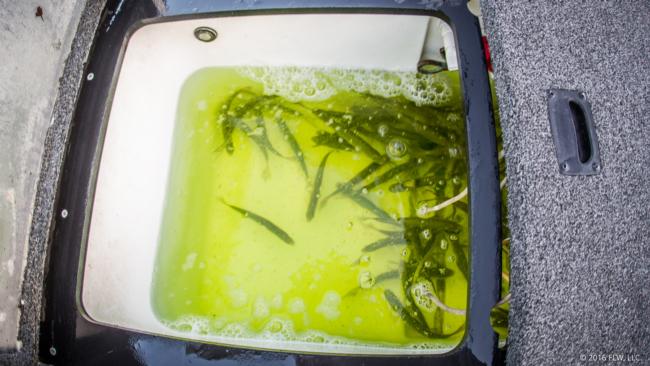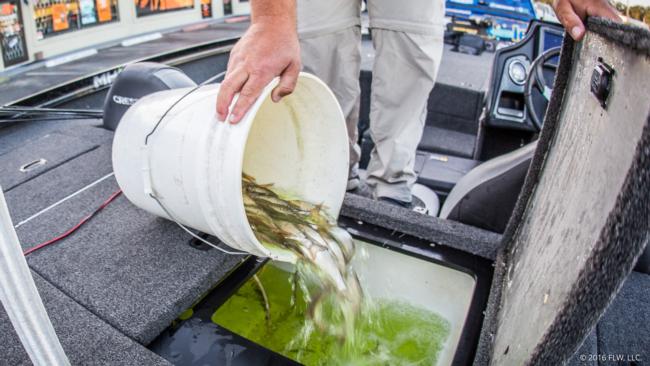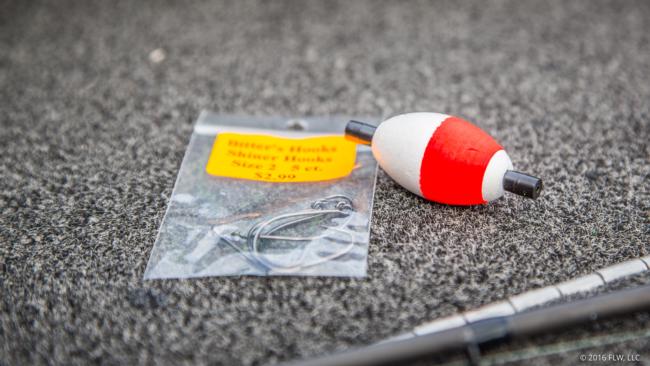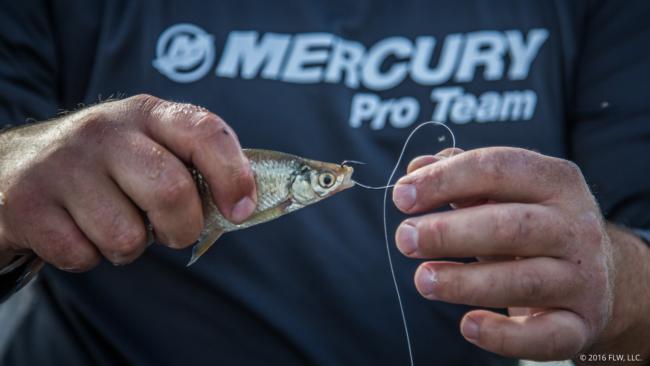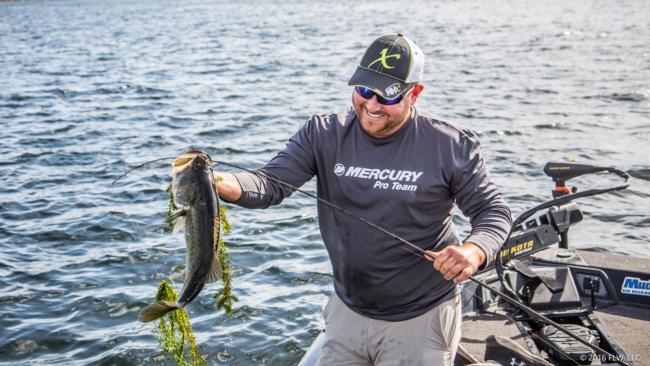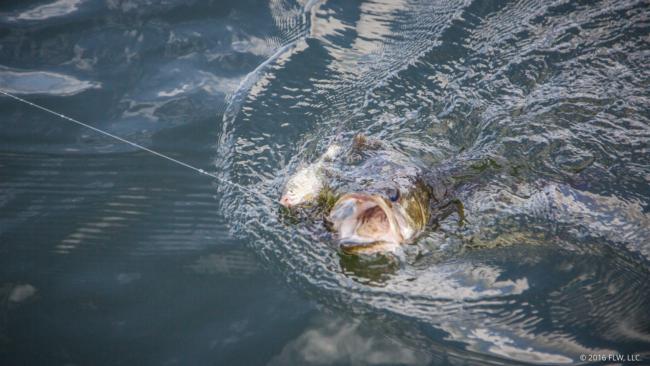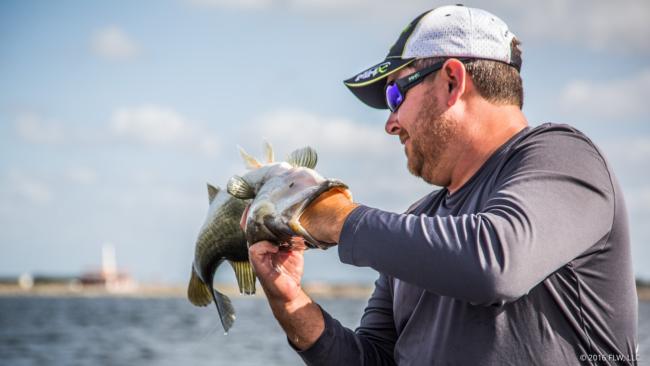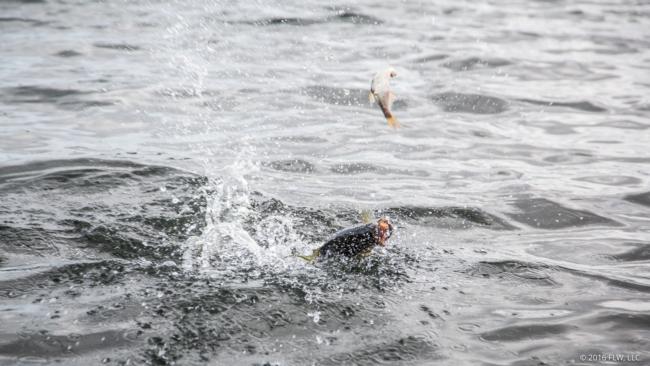Fish Shiners Like John Cox
How the Forrest Wood Cup champ loads the boat in Florida
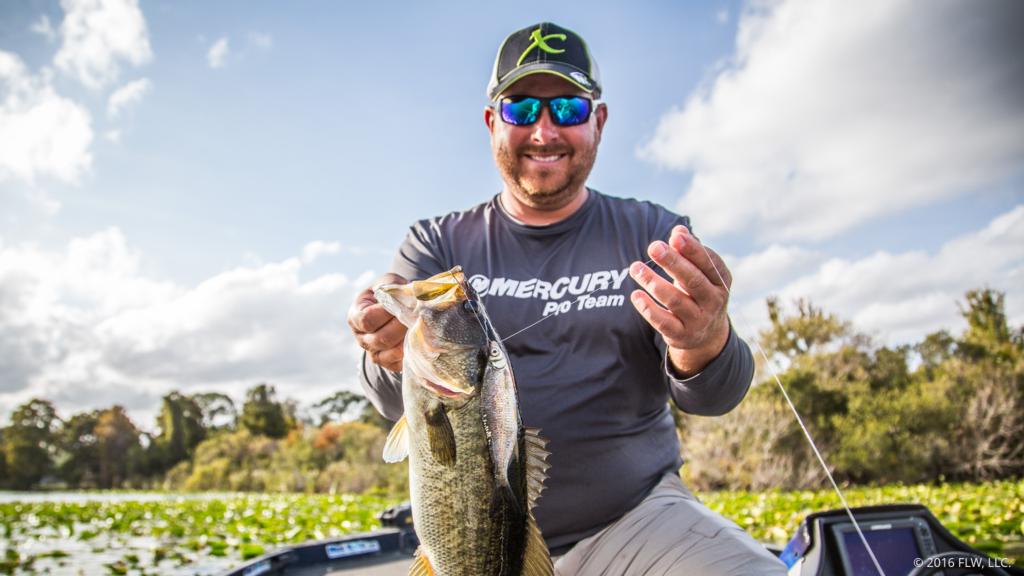
Fishing a shiner for big largemouths is a time-honored Florida tradition. For Forrest Wood Cup champ John Cox, it might be his favorite way to catch a bass.
“I like the excitement and the action,” says Cox. “You go artificial fishing, you’ll get some action here and there, but your slow time shiner fishing is going to be for about 15 minutes. I love the constant action of getting bites.”
If you’ve ever wanted to go shiner fishing for bass and didn’t know how to, the following video and article should answer most any questions you have.
Shiners
Native to North America, the golden shiner is one of the most widely spread fish in the world. Not because it’s some super-traveler, but because anglers love using golden shiners as bait. In Florida, big wild golden shiners are a delicacy for largemouth bass and highly sought after by anglers. Because shiners are hard to catch in the wild, it’s not uncommon for a dozen to cost more than $20.
There are two main sizes of shiners that Cox uses. Mostly, he uses shiners that are about 5 inches long – they’re more readily available and cheaper to purchase. In the late winter (just before the bass are thinking about spawning) and in the postspawn period, Cox likes to use big 12-inch shiners for a better chance at a true giant.
“The best day shiner fishing is when you have the best bait,” says Cox. “When you have the right bait it just ends up being a great day. I think my biggest bass ever came on like a 4-inch shiner. When you go out with the big ones you’re not going to get as many bites, but you’ll get some better hits.”
Regardless of the size, it’s important to keep them lively. Some stores will have better quality shiners than others, but keeping them healthy in your livewell is key as well. For that, Cox uses an aquarium bubbler hooked up to his trolling motor batteries. With the extra aeration, Cox says he can keep a batch of shiners alive for two or three days given cool weather.
The equipment
Fishing shiners doesn’t require any specialty equipment, but Cox does have some preferences.
When fishing with smaller shiners, Cox usually opts for a spinning rod. In his case, that’s a custom-built rod with an MHX blank. He spools up with 10- or 20-pound-test braided line and a 4-foot-long, 15-pound-test fluorocarbon leader joined with a blood knot.
“You pretty much just need a 7-foot, medium rod to handle them well,” says Cox. “You’re throwing that light braid and a pretty light leader, and it [the medium rod] lets you play the fish, so when you do get one of the big ones on it doesn’t break you off.”
For the bigger shiners, Cox usually picks up a baitcaster with 50-pound-test braid and a 20-pound-test leader.
“I like a rod that has a bit of backbone, because you’re using a bigger shiner, but enough tip so when that fish does decide to take off it’s not going to break you off,” says Cox. “The rod I mostly use is an MHX MB903. It’s 7-7, and you’ll get bend all the way down to the first guide. That’s what you want; you don’t want a complete crankbait rod, but something that’s similar.”
Cox rigs smaller shiners on a 2/0 shiner hook from Bitter’s Bait and Tackle and bigger shiners on a 4/0 hook. Sometimes Cox uses a bobber and prefers one with a split for the line so he can take it on and off easily.
Some old-school guys go with straight heavy mono and a flipping stick. Cox says mono is a good choice when fishing around docks because the thick line better withstands abrasion than thin braid. Yet, in most cases, using braid is a critical part of the equation for Cox.
“I like how much line you can pick up,” says Cox. “That shiner can have all your line out, and if you pick up on it and set the hook hard enough you’ll always drive the hook in. Also, with braid, the shiners swim better because there’s less resistance.”
How to hook them
There are two main ways to hook a shiner. The most common and all-purpose is to hook it through the top lip. It’s important to only hook the top because hooking both lips will prevent the shiner from breathing well in the water. The other way to hook a shiner is through the belly, just past the anal fin. Cox says that’s a particularly good method for when you want the shiner to swim under overhead cover.
Time and place
Winter and spring are the most common seasons for targeting big Florida bass with shiners.
“That’s when those big ones come up and you get multiple opportunities for big ones,” Cox says. “Any other time of year, you get shots at big ones, but in the winter and spring you get multiple opportunities.”
Shiners work all across Florida, from Okeechobee to the St. Johns River. Around his home in DeBary, Cox regularly fishes the St. Johns, the Harris Chain and a slew of smaller spring-fed lakes. If you’re in Florida, the odds are good that you’re near water with a shiner-eating bass.
“I fish the same stuff you would fish with artificials,” says Cox. “If you’ve got a floating mat that you would flip and get one bite out of with an artificial, you’ll probably catch 10 out of it with shiners. It really opens your eyes to how many fish are in there.”
Though you can fish shallow and around thick grass with shiners, fishing clearer areas can work particularly well. Thus, the outside of weed edges, deeper grass, deep holes and channels are also prime targets.
In most situations, Cox starts fishing with a bobber and adjusts it so that the shiner can swim close to the cover but not into it. On some days, particularly if the bass are less aggressive, he’ll free-line the shiner without a bobber. Bobber or no, Cox likes to either troll at about 30 or 40 percent power on his trolling motor to cover water or anchor up and fish around the boat. It simply depends on the type of area, the amount of wind and whether or not he’s located a pile of bass.
“There are a lot of spots that have a lot of fish, but the bite windows are really small,” adds Cox. “Even when you’re throwing a shiner, the bass will chase it and your shiner will get nervous, but they won’t eat until the bite window opens up. The main thing is to make sure your bait is clear of grass and lively so you’re ready.”
Getting them hooked
Handling a bite when shiner fishing is far different than when fishing a crankbait. You usually have some warning when a bass is looking at your shiner, because, although a hooked shiner usually just meanders through the water, it’ll get downright agitated when it’s in the sights of a lunker.
When bobber fishing, it’s easy enough to wait for the bobber to go down, feel it a bit and then set the hook. It’s a little different when free-lining a shiner.
“As soon as I feel that shiner get nervous I feed it a bit of line and let a few wraps around the spool come off, and then I grab it again,” says Cox, who always trolls his shiner with the bail open and a finger on the line. “You want to feel that ‘thunk’ and then let them take it for a couple seconds and set the hook.
“If they’re chasing it on top and running hard, I just open up the reel and let the bass do its thing. Once it gets it I’ll almost do a small hookset with the bail open to let some line out, then flip the bail and set the hook.”
Live bait issues
The only issue with live bait is that you’ll tend to gut-hook more bass than you would with artificial lures. Cox has caught thousands of largemouths on a shiner hook and guided many inexperienced anglers into bass. As such, he’s got a good method for saving hooks and bass.
“When you end up gut-hooking a fish, because it does happen, the best way to get it out is to flip the fish upside down and hold it in your hand,” says Cox. “That relaxes it, and its chompers won’t be closing down, and it won’t bite you. Then I reach my hand in there, and I run my pointer finger down the hook and to the barb and then push with my thumb. That turns the hook around, and then you can pop it right out.”
If you can’t master Cox’s removal technique, have no fear – he says just cutting the line and tying on a new hook is a great way to keep the bass alive too. In fact, he says he’s caught fish before from his pond that were in perfect condition that he knows have had hooks cut off in them in the past.
Get you some
“I prefer to go shiner fishing all the time,” says Cox. “There are times when I want to practice with artificials, and they [shiners] are so expensive I can’t afford to go all the time, but I would if I could.”
Shiner fishing is a great way to catch a bass, and whether you’re the Forrest Wood Cup champ or a 6-year-old, everyone likes catching a bass. So, the next time you decide to hit the water in Florida, at least think about bringing along some shiners.
